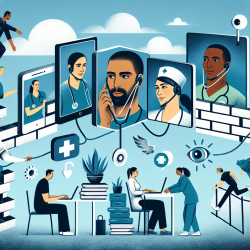Telehealth has revolutionized many aspects of healthcare, including vocational rehabilitation (VR) for trauma survivors. The recent study titled Factors Affecting the Delivery and Acceptability of the ROWTATE Telehealth Vocational Rehabilitation Intervention for Traumatic Injury Survivors: A Mixed-Methods Study provides valuable insights into the barriers and facilitators of delivering VR remotely. This blog will explore the key findings and offer practical tips for practitioners to enhance their telehealth VR services.
Key Barriers Identified
- Technology and Internet Access: Issues with digital devices and internet connectivity were significant barriers for both patients and therapists.
- Understanding Home/Work Context: Remote delivery made it challenging to assess the patient's environment accurately.
- Privacy and Disruptions: Ensuring privacy and minimizing disruptions during remote sessions were critical concerns.
- Building Therapeutic Rapport: Establishing a strong therapeutic relationship was more challenging remotely, especially through phone calls rather than video calls.
Effective Facilitators
- Reduced Travel Time: Both patients and therapists benefited from reduced travel time, allowing more frequent and flexible sessions.
- Increased Geographical Reach: Remote delivery enabled therapists to reach patients in distant or rural areas, improving access to VR services.
- Positive Patient Experiences: Many patients found remote sessions more comfortable and less stigmatizing, particularly when dealing with visible injuries.
- Enhanced Communication: Video calls facilitated better communication than phone calls, especially for patients with cognitive or communication challenges.
Practical Tips for Practitioners
Based on the study's findings, here are some practical tips for practitioners to improve their telehealth VR services:
- Ensure Reliable Technology: Invest in reliable digital devices and secure internet connections for both therapists and patients.
- Initial Face-to-Face Meeting: Consider an initial in-person meeting to better understand the patient's environment and establish rapport.
- Training and Support: Provide comprehensive training for therapists on remote delivery and offer ongoing support to address any challenges.
- Flexible Delivery Options: Incorporate a mix of remote and face-to-face sessions to cater to individual patient needs and preferences.
By addressing these barriers and leveraging the identified facilitators, practitioners can enhance the delivery and acceptability of telehealth VR interventions for trauma survivors.
To read the original research paper, please follow this link: Factors Affecting the Delivery and Acceptability of the ROWTATE Telehealth Vocational Rehabilitation Intervention for Traumatic Injury Survivors: A Mixed-Methods Study.










